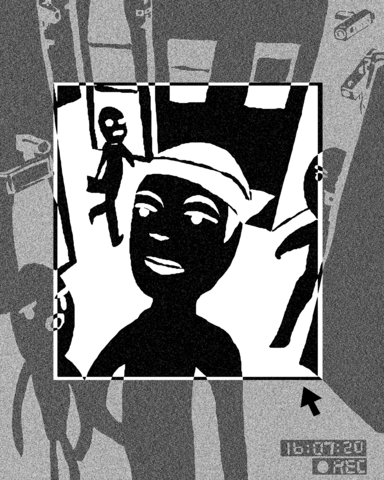The next time you walk by a shop window, take a glance at your reflection. How much do you swing your arms? Is the weight of your bag causing you to hunch over? Do you still have a bit of that 1970s disco strut left?
Look around -- You might not be the only one watching. The never-blinking surveillance cameras, rapidly becoming a part of daily life in public and even private places, may be sizing you up as well. And they may soon get a lot smarter.
Researchers and security companies are developing cameras that not only watch the world but also interpret what they see. Soon, some cameras may be able to find unattended bags at airports, guess your height or analyze the way you walk to see if you are hiding something.

Most of the cameras widely used today are used as forensic tools to identify crooks after-the-fact. (Think grainy video on local TV news of convenience store robberies gone wrong.) But the latest breed, known as "intelligent video," could transform cameras from passive observers to eyes with brains, able to detect suspicious behavior and potentially prevent crime before it occurs.
Surveillance cameras are common in many cities, monitoring tough street corners to deter crime, watching over sensitive government buildings and even catching speeders. Cameras are on public buses and in train stations, building lobbies, schools and stores. Most feed video to central control rooms, where they are monitored by security staff.
The innovations could mean fewer people would be needed to watch what they record, and make it easier to install more in public places and private homes.
"Law enforcement people in this country are realizing they can use video surveillance to be in a lot of places at one time," said Roy Bordes, who runs an Orlando, Florida-based security consulting company. He also is a council vice president with ASIS International, a Washington-based organization for security officials.
The advancements have already been put to work. For example, cameras in Chicago and Washington can detect gunshots and alert police. Baltimore installed cameras that can play a recorded message and snap pictures of graffiti sprayers or illegal dumpers.
In the commercial market, the gaming industry uses camera systems that can detect facial features, according to Bordes. Casinos use their vast banks of security cameras to hunt cheating gamblers who have been flagged before.
In London, one of the largest users of surveillance, cameras provided key photos of the men who bombed the underground system in July 2005 and four more who failed in a second attempt just days later. But the cameras were only able to help with the investigation, not prevent the attacks.
Companies that make the latest cameras say the systems, if used broadly, could make video surveillance much more powerful. Cameras could monitor airports and ports, help secure homes and watch over vast borders to catch people crossing illegally.
Intelligent surveillance uses computer algorithms to interpret what a camera records. The system can be programmed to look for particular things, like an unattended bag or people walking somewhere they don't belong.
"If you think of the camera as your eye, we are using computer programs as your brain," said Patty Gillespie, branch chief for image processing at the Army Research Laboratory in Adelphi, Maryland. Today, the military funds much of the smart-surveillance research.
At the University of Maryland, engineering professor Rama Chellappa and a team of graduate students have worked on systems that can identify a person's unique gait or analyze the way someone walks to determine if they are a threat.
A camera trained to look for people on a watch list, for example, could combine their unique walk with facial-recognition tools to make an identification. A person carrying a heavy load under a jacket would walk differently than someone unencumbered -- which could help identify a person hiding a weapon. The system could even estimate someone's height.
With two cameras and a laptop computer set up in a conference room, Chellappa and a team of graduate students recently demonstrated how intelligent surveillance works.
A student walked into the middle of the room, dropped a laptop case, then walked away. On the laptop screen, a green box popped up around him as he moved into view, then a second focused on the case when it was dropped. After a few seconds, the box around the case went red, signaling an alert.
In another video, a car pulled into a parking lot and the driver got out, a box springing up around him. It moved with the driver as he went from car to car, looking in the windows instead of heading into the building.
In both cases, the camera knew what was normal -- the layout of the room with the suspicious bag and the location of the office door and parking spots in the parking lot. Alerts were triggered when the unknown bag was added and when the driver didn't go directly into the building after parking his car.
Similar technology is currently in use by Marines in Iraq and by the subway system in Barcelona, according to ObjectVideo, a Reston, Virginia, firm that makes surveillance software.
ObjectVideo uses a "tripwire system" that allows users to set up virtual perimeters that are monitored by the cameras. If someone crosses that perimeter, the system picks it up, sends out an alert, and security staff can determine if there is a threat.
Company spokesman Edward Troha predicts the technology, currently designed primarily to protect borders, ports and other infrastructure, could be adapted to help prevent retail theft or guard private homes.
The Jacksonville Port Authority uses ObjectVideo software as part of its security measures to watch the perimeter of the Florida port that handles 8.7 million tonnes of cargo and thousands of cruise ship passengers each year. The surveillance system sends real-time video from anywhere at the port of possible intruders to patrol cars.
Still, industry officials say the technology needs to improve before it can be widely used. There are liability issues, such as if someone is wrongly tagged as a threat at an airport and misses a flight, said Bordes. Troha warns humans are still essential to intelligent video, to tell, for example, if a person in a restricted area is a danger or just lost.
And the cameras can only see so much -- they can't stop some threats, like a bomber with explosives in a backpack. They can't see what you are wearing under your jacket -- yet.
"That is an eventual goal, but we're not there yet," Chellappa said.

In the past month, two important developments are poised to equip Taiwan with expanded capabilities to play foreign policy offense in an age where Taiwan’s diplomatic space is seriously constricted by a hegemonic Beijing. Taiwan Foreign Minister Lin Chia-lung (林佳龍) led a delegation of Taiwan and US companies to the Philippines to promote trilateral economic cooperation between the three countries. Additionally, in the past two weeks, Taiwan has placed chip export controls on South Africa in an escalating standoff over the placing of its diplomatic mission in Pretoria, causing the South Africans to pause and ask for consultations to resolve
An altercation involving a 73-year-old woman and a younger person broke out on a Taipei MRT train last week, with videos of the incident going viral online, sparking wide discussions about the controversial priority seats and social norms. In the video, the elderly woman, surnamed Tseng (曾), approached a passenger in a priority seat and demanded that she get up, and after she refused, she swung her bag, hitting her on the knees and calves several times. In return, the commuter asked a nearby passenger to hold her bag, stood up and kicked Tseng, causing her to fall backward and
In December 1937, Japanese troops captured Nanjing and unleashed one of the darkest chapters of the 20th century. Over six weeks, hundreds of thousands were slaughtered and women were raped on a scale that still defies comprehension. Across Asia, the Japanese occupation left deep scars. Singapore, Malaya, the Philippines and much of China endured terror, forced labor and massacres. My own grandfather was tortured by the Japanese in Singapore. His wife, traumatized beyond recovery, lived the rest of her life in silence and breakdown. These stories are real, not abstract history. Here is the irony: Mao Zedong (毛澤東) himself once told visiting
When I reminded my 83-year-old mother on Wednesday that it was the 76th anniversary of the founding of the People’s Republic of China, she replied: “Yes, it was the day when my family was broken.” That answer captures the paradox of modern China. To most Chinese in mainland China, Oct. 1 is a day of pride — a celebration of national strength, prosperity and global stature. However, on a deeper level, it is also a reminder to many of the families shattered, the freedoms extinguished and the lives sacrificed on the road here. Seventy-six years ago, Chinese Communist leader Mao Zedong (毛澤東)